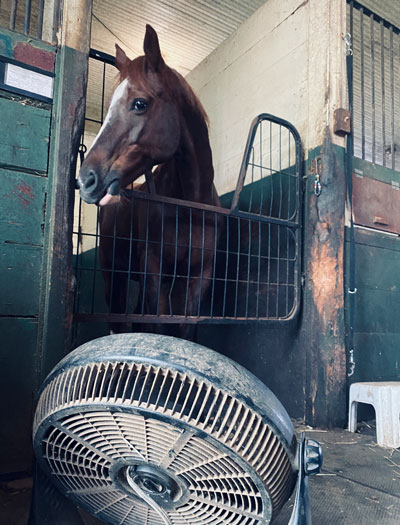
When I bought my pony, Ferrous, the former owner disclosed that he had trouble sweating, but a supplement was all he needed to be healthy in the summer. In truth, I quickly realized how anhidrosis, the inability to sweat properly, affected my horse year-round despite supplements. I took him out of the show ring, kept exercise to a minimum, and largely took the summers off to keep him comfortable and healthy.
What is Anhidrosis?
Signs of Anhidrosis
Generally, anhidrosis is diagnosed through clinical signs, although there are tests your veterinarian can perform to make an official diagnosis. Owners and trainers are the line of first defense as they are the ones untacking after exercise. While most horses may be quite lathered after work, a horse with anhidrosis or “no sweat” may have limited sweat marks under saddle that gradually decrease over time. For example, in spring my pony often shows sweat marks under the girth but not under the saddle pad. As the weather continues to warm and especially during heat waves, I begin to see zero sweat patterns at all. Additional clinical signs include panting or heaving, increased heart rate, dehydration of the skin, or increased body temperature over 104 degrees.

How to Care for a Horse with No Sweat
The reality of anhidrosis is complicated but should not necessarily be something to prevent you from purchasing a horse. While many animals do well on a daily supplement, often they do not do enough to achieve the perspiration that is needed to properly regulate body temperature. Horses with mild signs may take the supplement during warmer months while animals that do not sweat well regardless of temperature should include this in their feed year-round. In addition to diet and nutrition, there are a few other things horse owners can do to keep a horse comfortable.
- Stall your horse during the day, away from the heat and sun.
- Provide access to fans or misters to keep him cool.
- Hose down your horse during the hottest part of the day and allow him to naturally evaporate the water in his stall (don’t remove excess water!).
- Feed electrolytes or salt mixtures.
- Give him a lot of fresh water. I’ve recently found Hydration Hay by Forage Solutions, which is put in a bucket of water and expands to encourage them to eat and drink.
- Avoid exercise during hot, summer months. If you intend to compete during that time, an anhidrotic horse may not be the choice for you.
Dr. Ian Baines, DVM, who is on the academic staff at the School of Veterinary Medicine, University of Namibia, and is a FEI 4* endurance vet, has dealt with two cases during his career, and both showed exercise intolerance and overheating after only moderate exercise.
“Namibia has a relatively hot and dry climate (low humidity), so symptoms in anhidrotic horses are easily exacerbated,” he says. “No treatment was attempted. Literature tells us most medical treatment is experimental at best and gives poor results. Managing these cases by exercising early in the morning, using cold water sprayers and regular hosing down proved futile and both cases retired from competition. I have reports of some pretty positive outcomes from regular acupuncture, which may be something worth investigating.”
While cases are relatively rare, the eastern United States and the southeastern United States are high in humidity and cases tend to be higher. If you see signs of limited sweating, please consult your veterinarian for a diagnosis.
I constantly worry about my pony’s comfort and health. While my friends go on hunter paces and long trail rides, we cannot join because it’s dangerous for us even during the fall because of his severe signs. We have limitations that other horses don’t, but I wouldn’t trade him for the world. I’m grateful that I can give Ferrous what he needs to live his most comfortable life. I haven’t had to move us to the Arctic yet, but I certainly won’t rule out the possibility.





